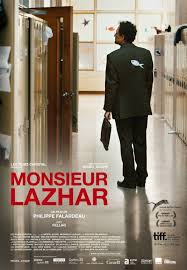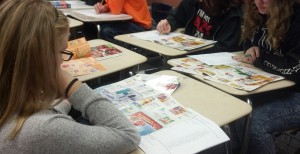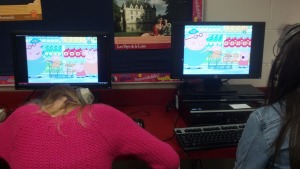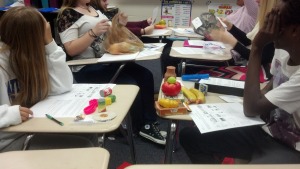I have been reading Petit Nicolas stories with my students since I began teaching 25 years ago. Although a lot of the resources on interpretive reading assessment tend to focus on non-fiction, I think that it is important to make sure that we are also exposing our students to literature from the target culture. My students have always enjoyed reading these stories, and look forward to watching the live action film in the spring. In addition, the cartoon videos provide an excellent authentic resource for interpretive listening. For these reasons, I developed a mini-unit around the Petit Nicolas story, “Les Campeurs” for my French 3 students after our vacation unit this fall. Here’s a pdf of the story, if you don’t have a copy of the book. 4-Les campeurs
I began this mini-unit by presenting some of the new vocabulary that the students would be seeing in the story. To do so, I made a PowerPoint with a slide for each of the images on the handout included in the file. I showed the PowerPoint and asked questions which included the words in order to familiarize the students with the vocabulary and scaffold the interpretive task. Although I don’t often pre-teach vocabulary in this way, the feedback from the students was that it was really helpful. An unintended consequence of this activity was that the students began to make predictions about what the story would be about—an important step in the reading process.
After the vocabulary presentation, I gave the students the interpretive task for Part 1 of the story, which I developed according to the template in the ACTFL IPA manual. Due to the length of the story, I divided it into two parts, and wrote a separate assessment for each one. In order to avoid requiring the students to spend two days on silent reading, I allowed them to complete the assessment for Part I in small groups. This also allowed the Part 1 task to serve as a formative assessment for the mini-unit.
While the students did well on this assessment and enjoyed reading the first part of the story, I wanted to include some target-language discussion of Part 1 before assessing their comprehension on Part 2. A drawback to using the ACTFL IPA template is that the questions are in English. While I agree that this is the best way to assess reading, it doesn’t provided the springboard I needed for a target language discussion. Therefore, I designed a series of inference-based French questions and had the students discuss them in small groups, after which we discussed them as a class. Their responses to these questions let me know that even those students who had performed well on the formative assessment were not reading deeply enough to understand many of the humorous details in the story. I also discovered that my students would have benefited from being given additional background information about the stories. For example, one student asked, “Why do you keep calling this story Petit Nicolas, there’s not even a Nicolas in it?” I had not realized that it would not be obvious to these students that the story was being narrated in the first person—Oops!
I was pleased with the students’ discussion of these inference questions, and felt that they really encouraged a more detailed reading of the text. I also realized that the ACTFL IPA template was most likely not designed for this type of reading task. While reading for the main idea and a few supporting details are appropriate authentic tasks for non-fiction texts, literature is best enjoyed when read with attention to more subtle details, in order to more fully appreciate the humorous aspects of the text. I’ll make sure to develop more appropriate interpretive assessments for these stories in the future.
After the discussion of the inference-based French questions, I felt the students were ready for the Part 2 Interpretive assessment. They completed this individually so that I could use it as a summative assessment/part of their IPA for the mini-unit.
In addition to this Interpretive Reading task, I assessed the students’ interpretive listening skills by having them watch the cartoon video which corresponds to this story. Note: the plot of the two stories is significantly different! These differences are important, because they allow me to assess the students’ listening comprehension, rather than their memory of the story. While this video is somewhat more difficult than others they had watched, the students felt very confident about their ability to understand it. I think that the questions themselves provided a lot of scaffolding for the interpretive task.
For the Interpersonal Communication task, I assigned a role play in which Clotaire asks Nicolas to go camping again. I allowed the students to practice this role play for about 30 minutes before being assessed, but did not allow them to choose which role they would play, or who their partner would be. In this way I can ensure that the task is actually interpersonal, and not just memorization of a script.
For the Presentational Writing task, the students wrote a note from Nicolas to his grandmother, asking for a tent for his birthday. As is my practice, the students wrote a rough draft (formative assessment), I provided feedback (using the abbreviations on the feedback form) and then they wrote a final draft, which was their IPA score. In the future I would make my expectations more clear, as some of the letters were general in nature, rather than incorporating specific details from the story.
Here’s a file with the materials I created for this story:campeurs_file
I’d love to hear from others who have incorporated Petit Nicolas stories into their proficiency-based classrooms. What types of interpretive tasks have worked for you?










